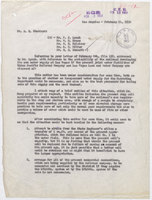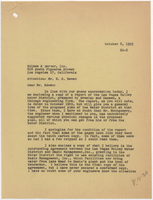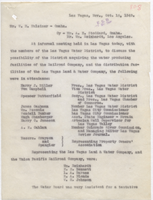Search the Special Collections and Archives Portal
Search Results

Extract of minutes of special meeting of board of directors of Las Vegas Land and Water Company, held June 29, 1953
Date
Archival Collection
Description
Extract of meeting notes where the water company board approved of its sale to the water district. Document has embossed seal of Las Vegas Land and Water Company at the bottom.
Text

Letter from William Reinhardt (Los Angeles) to A. E. Stoddard, February 11, 1952
Date
Archival Collection
Description
Discussion of the advisability of the railroad developing its own water source if the Water District purchases Las Vegas water production.
Text

Letter from E. E. Bennett (Los Angeles) to William Reinhardt, January 4, 1952
Date
Archival Collection
Description
The Nevada State Engineer suggested that the Las Vegas Valley Water District purchase 1200 acres of "water bearing lands," but the District only wanted to purchase 679 acres.
Text

Letter from E. E. Bennett to E. G. Bowen (Los Angeles), October 8, 1953
Date
Archival Collection
Description
Discussion on the water district's report on the condition of the Las Vegas water supply and their bond issue.
Text

Correspondence from L. A. Barnes (Las Vegas) to W. H. Hulsizer (Omaha), October 12, 1949
Date
Archival Collection
Description
Summary notes of a meeting between the Las Vegas Valley Water District and the Las Vegas Land and Water Company regarding the possible sale of water production to the district.
Text
Nevada Women's History Project Records
Identifier
Abstract
The Nevada Women's History Project Records (1995-2008) contain the early organizational records of the Nevada Women's History Project (NWHP), which was created to collect and disseminate information about women throughout Nevada's history. The collection reflects the early organization of the Nevada Women's History Project's (NWHP) Southern region and the variety of events and projects with which the organization was involved with across the state of Nevada. Materials include membership lists, meeting minutes, press releases, project files, and NWHP newsletters.
Archival Collection
Nita Longo Rieger Collection on the Desert Chapter of Gold Star Mothers
Identifier
Abstract
The Nita Longo Rieger Collection on the Desert Chapter of Gold Star Mothers consists of materials dated from 1947 until 1995 from the Desert Chapter of Gold Star Mothers Inc. located in Las Vegas, Nevada. It includes newspaper clippings about the group, a history of the chapter, photographs of meetings and member events, and programs from the dedication and rededication of a monument erected by the group.
Archival Collection
KNPR: "Monday Night Jazz" Program Documentation and Recordings
Identifier
Abstract
The KNPR: "Monday Night Jazz" Program Documentation and Recordings focus on jazz music played at the Four Queens Hotel and Casino in Las Vegas, Nevada from 1982 to 1997. The materials contain the reel-to-reel audio tapes from the radio programs that were taped at the Four Queens Hotel, including unedited master recordings and the edited versions played on air by Nevada National Public Radio (KNPR). Materials also include contracts, newspaper clippings, correspondence, photographs, and jazz scheduling information related to the program.
Archival Collection
Steve Round Memorial Book of the 1 October Shooting in Las Vegas
Identifier
Abstract
This collection is comprised of a memorial book filled with handwritten condolences, memorials, and prayers for the victims of the mass shooting that occurred on October 1, 2017 at the Route 91 Harvest music festival in Las Vegas, Nevada. From October 2-10, 2017, Steve Round watched over a memorial that spontaneously developed in the median of Las Vegas Boulevard near the site of the shooting. Round invited visitors at the memorial, including families and friends of the victims, community members, first responders, and tourists, to sign the book.
Archival Collection
Kay Royer Red Cross Scrapbook
Identifier
Abstract
The Kay Royer Red Cross Scrapbook contains black-and-white photographic prints, newspaper clippings, and personal correspondence collected by Sarah "Kay" Royer while stationed at the 248th General Hospital and 4th General Hospital in the Philippines from 1945 to 1948. The scrapbook contains newspaper clippings with commentary written by Royer documenting her training at the American University in Washington, D.C., the journey to Manila, and her time spent there working in various hospitals. Included in the scrapbook are letters from soldiers thanking the nurses for their care, dance cards, menus from holidays and special occasions, and hand-drawn sketches given to Royer.
Archival Collection
